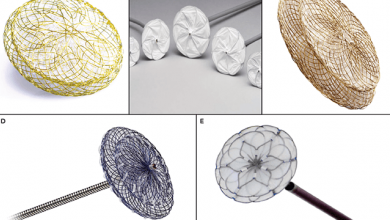Search results
Author(s):
Joelle Kefer
Added:
3 years ago
Atrial septal abnormalities are common congenital lesions remaining asymptomatic until adulthood in a great number of patients. The most frequent atrial septal defects in adults are ostium secundum atrial septal defect (ASD) and patent foramen ovale (PFO), both approachable by transcatheter closure using device implantation. The first non-surgical ASD closure was performed in 1975 by Mills and…
View more
Author(s):
Jan Balzer
,
Tobias Zeus
,
Verena Veulemans
,
et al
Added:
3 years ago
Percutaneous catheter-based structural heart disease procedures are a rapidly growing area of interventional cardiology, and represent a valuable option for cardiac patients with comorbidities who are ineligible for conventional surgery as well as demonstrating excellent outcomes.1,2 Catheter-based interventions include transcatheter aortic valve implantation (TAVI),3 percutaneous mitral valve …
View more
Author(s):
Satinder K Sandhu
Added:
3 years ago
Over the last three decades numerous transcatheter therapies for the treatment of congenital heart disease (CHD) have been developed.
Interatrial Septal Defect
Balloon atrial septostomy has been performed in patients with transposition physiology and in patients where egress of blood is needed from the left or the right atrium and in adults with pulmonary vascular disease where the creation of…
View more
Author(s):
Jennifer Franke
,
Nina Wunderlich
,
Horst Sievert
Added:
3 years ago
As an intra-cardiac right-to-left shunt, the patent foramen ovale (PFO) has gained attention over the last two decades because of its potential pathological importance in a number of disease processes including stroke, peripheral embolism, systemic oxygen desaturation (i.e. hypoxaemia) and migraine headaches. Percutaneous PFO closure, using a double-umbrella Clamshell device (Bard, USCI,…
View more
Author(s):
Amar Krishnaswamy
,
Emin Murat Tuzcu
,
Samir R Kapadia
Added:
3 years ago
Among patients undergoing surgical valve replacement, 1–5 % of patients with an aortic valve replacement (AVR) and 2–12 % with a mitral valve replacement (MVR) may develop paravalvular regurgitation or ‘leak’ (PVL).1–3 In the era of transcatheter aortic valve replacement (TAVR) with first-generation balloon expandable valves, up to 17 % of patients may be left with moderate or severe PVL, also…
View more
Author(s):
Sameer Gafoor
,
Jennifer Franke
,
Stefan Bertog
,
et al
Added:
3 years ago
Paravalvular leak (PVL) occurs when there is backflow around a prosthetic valve. This can occur through a variety of causes. Paravalvular Leak is accompanied by regurgitation and is often a significant problem for patients with bioprosthetic or mechanical heart valves.1 Often manifesting as heart failure (85% of all presenting symptoms) and hemolysis (13–47% of all presenting symptoms and signs)…
View more
Frontiers of Patent Foramen Ovale Closure and New Design Improvements - A Review of the Literature
Author(s):
Raquel del Valle-Fernández
,
Carlos E Ruiz
Added:
3 years ago
Article
Author(s):
Nina Wunderlich
,
Jennifer Franke
,
Neil Wilson
,
et al
Added:
3 years ago
Imaging guidance is of major importance for successful outcomes in the interventional treatment of structural, congenital and valvular heart disease. Cardiac transcatheter treatment of these diseases is a rapidly growing field and, as a result, there has been substantial progress in image-guidance technology.
During interventions, the major imaging focus is currently on echocardiography, which…
View more
Author(s):
Joel P Giblett
,
Lynne K Williams
,
Stephen Kyranis
,
et al
Added:
3 years ago
Patent foramen ovale (PFO) is common and occurs in 20–34% of the population.1 In most infants, the foramen ovale closes soon after birth, with a reduction in pulmonary vascular resistance raising the left atrial pressure above that of the right atrium during the first few breaths, closing the septum. In a significant proportion of individuals, the primum and secundum atrial septa do not fuse, and…
View more
Author(s):
Joel P Giblett
,
Omar Abdul-Samad
,
Leonard M Shapiro
,
et al
Added:
3 years ago
Patent foramen ovale (PFO) is a common abnormality, occurring in 20–34% of the population.1 In the majority of infants, closure of the foramen ovale occurs soon after birth, as negative intrathoracic pressure associated with the first breaths closes the PFO. In some cases, the primum and secundum atrial septa fail to fuse and closure remains incomplete. There is continuing communication between…
View more











